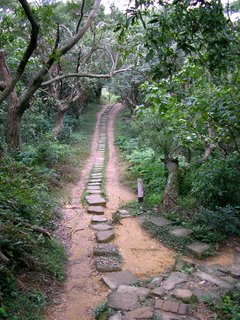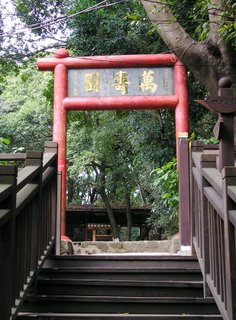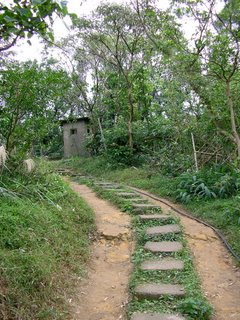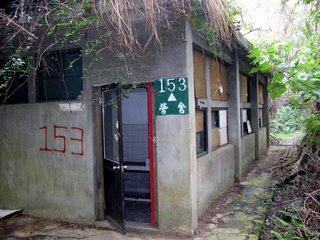Venturing up from a trail behind the hotel, one quickly finds that the dense forest canopy hides a network of trails and stairways crisscrossing the hillside. The walkways range from nicely laid cobblestone paths and wooden walkways, to crudely laid trails.
The paths connect dozens of small pavillions, temples, gardens, scenic overlooks, and badminton courts. Most of these were built by private individuals, but are open to all. There's nothing quite like playing a game of badminton on a court cut into the hillside, where you can peer out from an opening in the trees to the city below. The area is popular with locals, especially in the morning where you can see these areas filled with people practicing martial arts, exercising, or playing Chinese chess.
 A badminton court with a hell of a view.
A badminton court with a hell of a view.The hill exists almost as a place frozen in time, away from the bustle of the city just a few hundred meters below. The sounds of traffic and the city are barely audiable, and are drowned out by the chirps of birds, the soft tap of walking sticks... and the occasional sound of karioke from a TV and machine someone managed to bring up (hey, nothing's perfect). Wandering along the pathways, one can find relics of bygone days. It seems people since the 70s (at least) have been trekking through this area and slowly building up the things which can be seen today.
Yet despite this, the man made structures (crude though they are), seem to fit right in alongside the trees and vegetation, rather then fighting against them. It's difficult to describe, but everything seems to meld together naturally... trees, bushes, stone, and concrete.
Wandering deeper into the forested slopes along the maze of trails, one comes to the remminents of a former military encampment. Once, decades ago, soldiers would walk along the trails marked by neatly laid concrete blocks, while manning anti-aircraft stations keeping watch over the capital.
The old military trail runs along the main ridge, marked by regularly placed concrete blocks (and for the perceptive, a half buried cable presumebly once used for communications), dotted with guardhouses and pillboxes at regular intervals. After walking for what seems like forever, I finally reach the end, guarded by a final pillbox, inaccessible due to the overgrowth. Some people have taken it upon themselves to create a small rest area here, complete with plastic stools and crude benches made by lashing long rods of bamboo between trees, and a clock above which is placed a sign "老地方" (The Old Place).
Today, the soldiers and the antiaircraft guns are long gone... moved to other locations on the outskirts of the city and replaced with newer systems. But the trails walked by patrols are now traversed by hikers who pass by the small barracks, guardhouses, and pillboxes with peeling green paint, and still make use of the old exercise equipment once used by soldiers.

Jiantan Shan could very well be a metaphor for many things in Taiwan today... in plain view, ignored by most, but revealing many hidden treasures if you take the time to venture beyond where most people stop.
[Taiwan],
[Taipei]







No comments:
Post a Comment